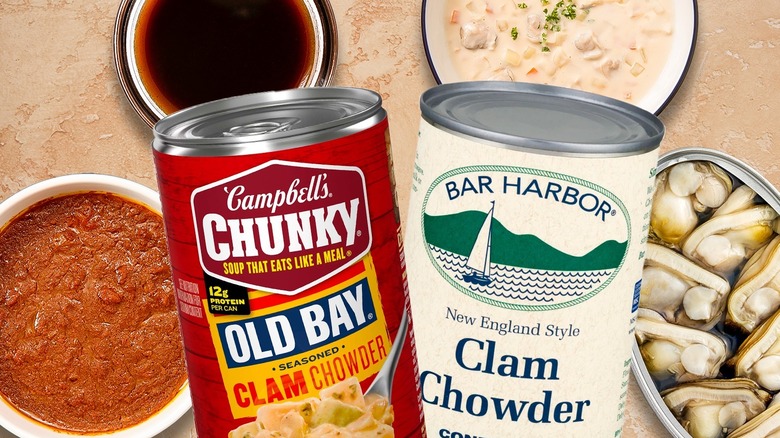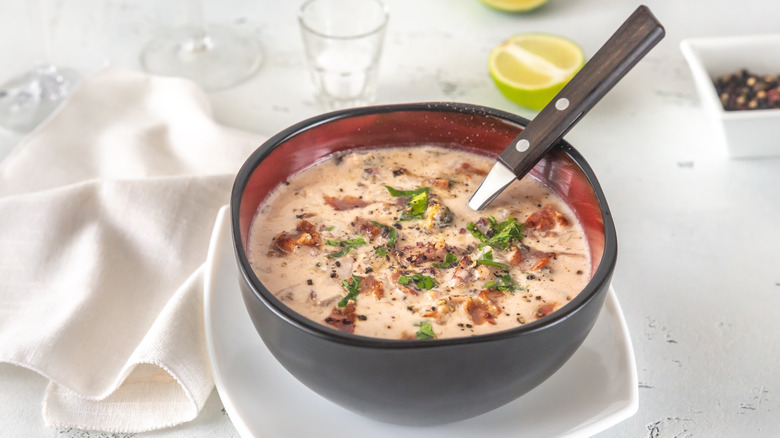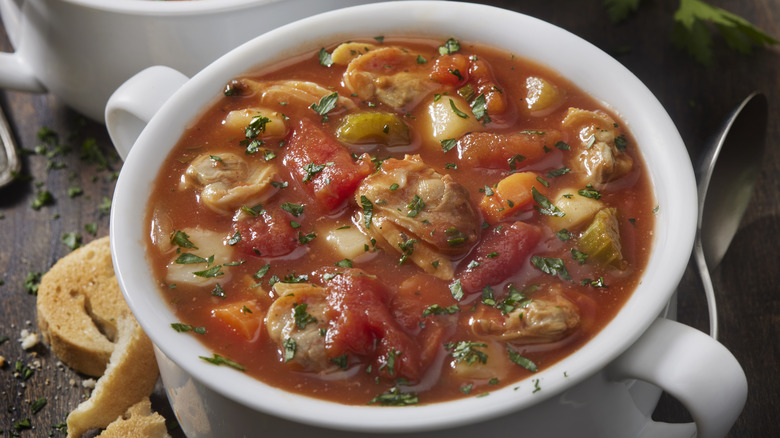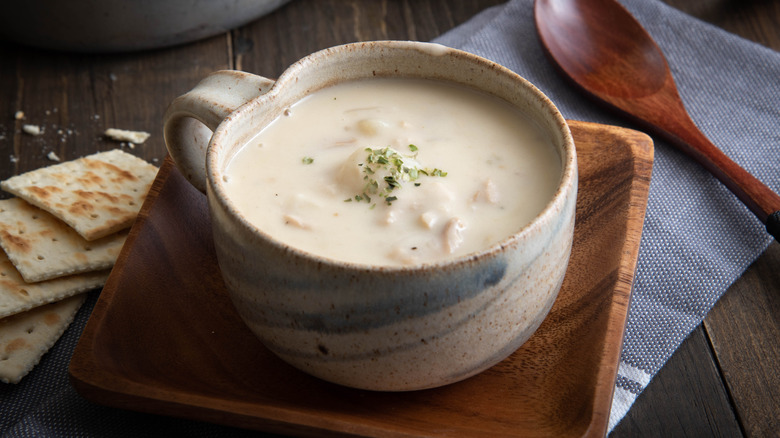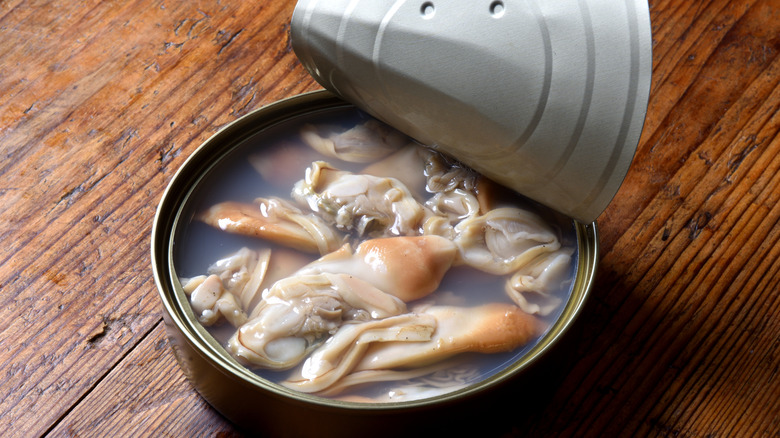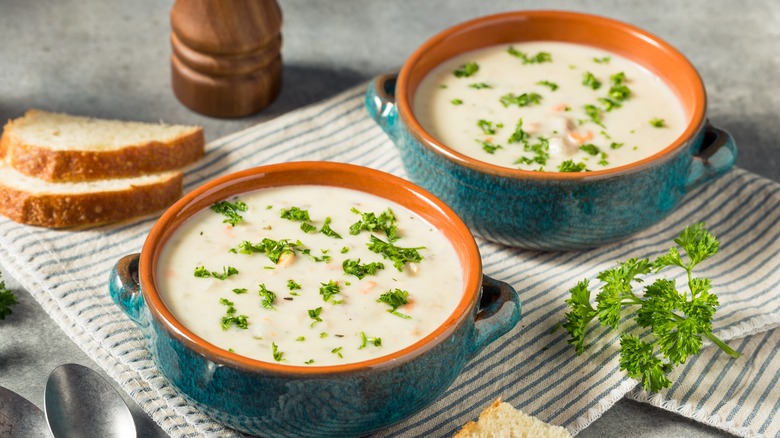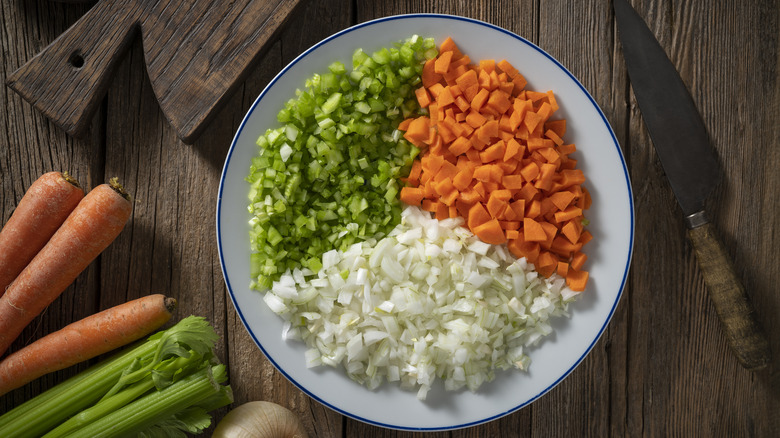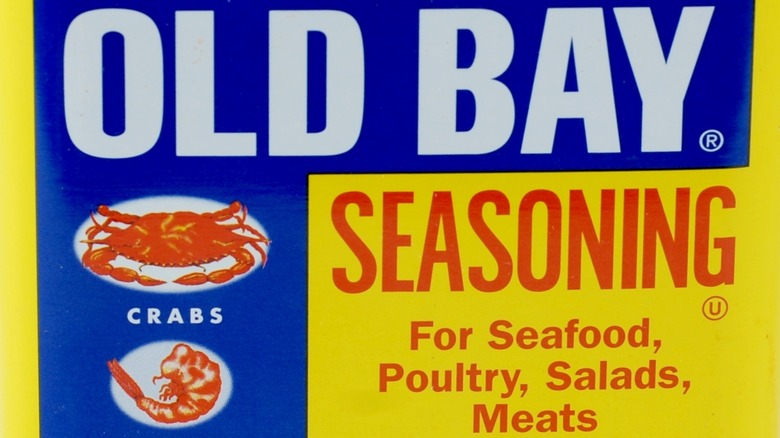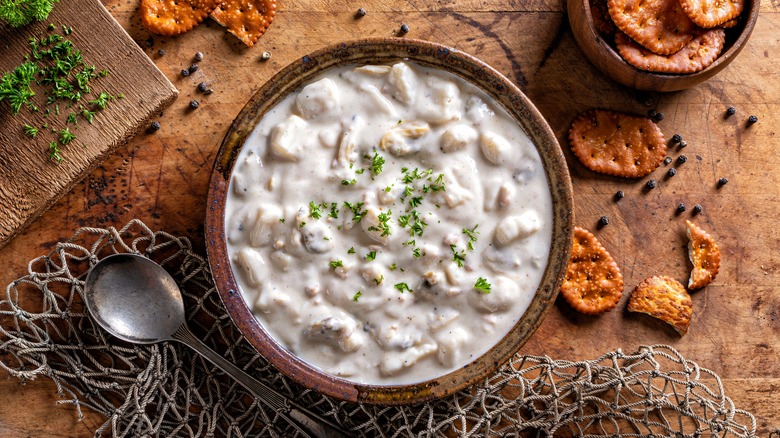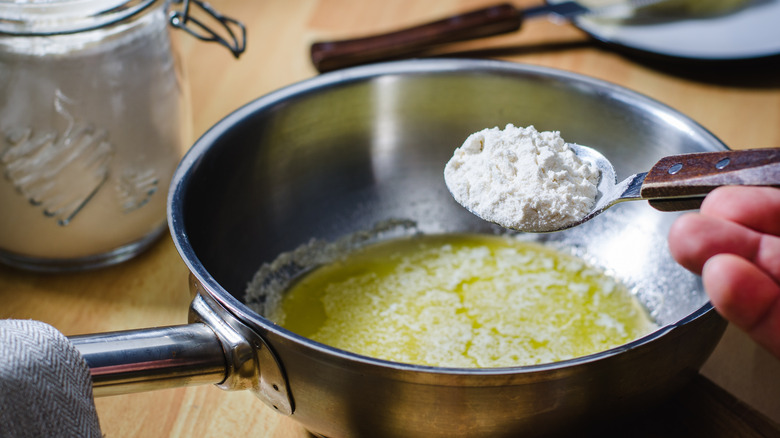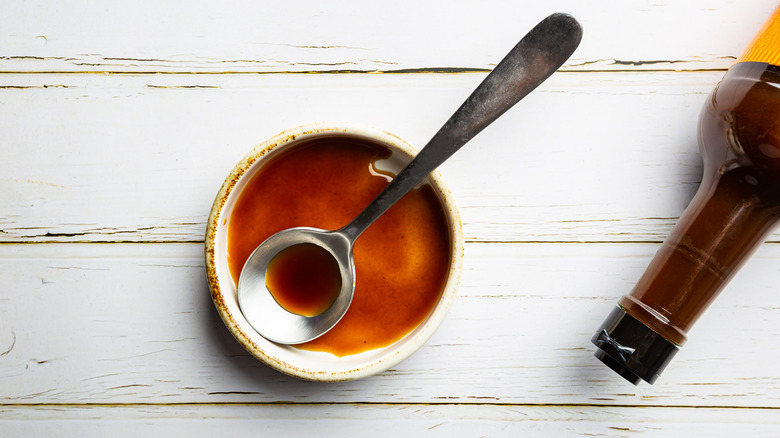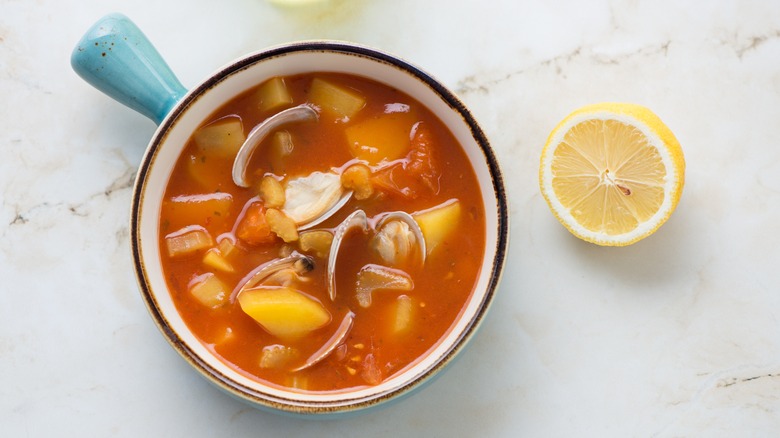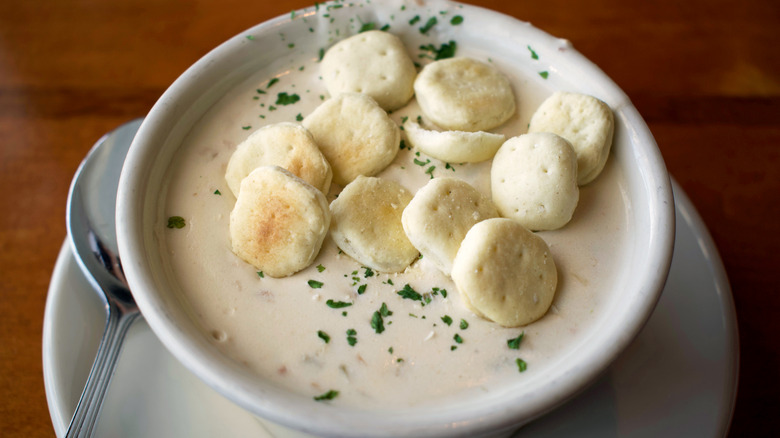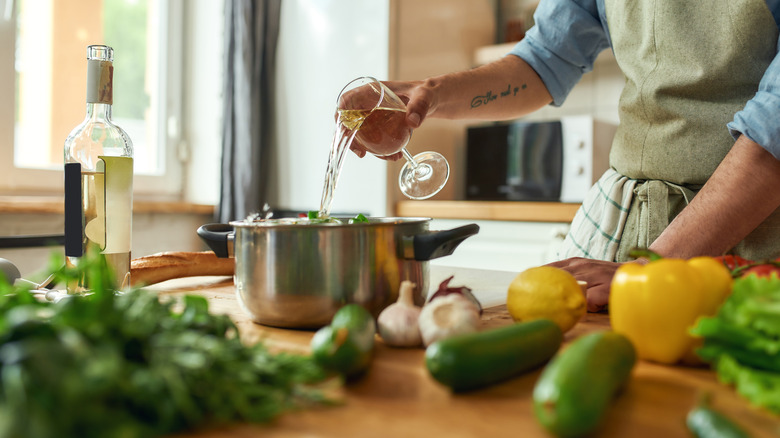14 Ways To Make Canned Clam Chowder Taste Homemade
Clam chowder is an American classic with an impressive history. It's not clear who first assembled a variation of this hearty dish, but by 1836, it was already a staple at Boston's Ye Olde Union Oyster House, which is believed to be one of the oldest continually operating restaurants on U.S. soil. Chowder is not necessarily made with clams, but this seafood favorite has variations that pop up all along the East Coast. The most popular is probably the New England clam chowder, easily identified by its milky, off-white broth dotted with clams and potatoes. A runner-up is certainly the Manhattan chowder with its red, tomato-infused broth, while Rhode Island opts for a clear base where clam juice is the star of the show.
Clam chowder is a restaurant staple, and though many homemade versions of this classic are built from scratch, there is a convenient shortcut in the form of canned clam chowder. Arguably, these are not the best versions out there, but they can be perfected with a few ingredients and minimal skill. We've assembled the best ideas to dress up your canned chowder and give it a fresh, homemade look.
As a bonus tip, we suggest choosing a reliable brand and good-quality clam chowder, as it will be much easier to upgrade at home. If you're starting with something of poor quality, even high-end ingredients can't salvage it. Check out Mashed's ranking of canned clam chowders to help you choose the best one.
Add bacon for texture and flavor
One of the best ways to improve any dish is to add bacon. This undisputed MVP can give your dish more character and depth. It is especially valuable when added to store-bought items that typically need just a gentle nudge to bring the flavors together.
Despite being a seafood specialty, adding bacon to clam chowder should not be unusual, as many New England versions commonly used salt pork to give the dish a nice meaty background. Salt pork is similar to bacon, and is typically made from fatback or pork belly. The meat is rubbed with salt, sometimes together with sugar, and after a short curing process, it's rinsed and ready for use. In traditional clam chowder, bits of salt pork are rendered, and the fat is preserved for sauteing veggies, while the crispy bits are incorporated into the broth.
As salt pork is not so common anymore, you can easily replace it with slab bacon. Try to refrain from overly smoky products, as they might overwhelm the whole thing. Render your pork first — skip or add the fat to the chowder, depending on preference — and then top the bowl of comforting chowder with some crunchy bacon bits for more flavor and texture.
Spice it up with chile peppers or hot sauce
Even if you're not a fan of hot spices, consider adding some to canned chowder. Fresh chiles are a great option for the tomato-based Manhattan-style chowder. They will blend nicely, and the dish can only benefit from a touch of herbaceous profile and heat. For the classic New England version, don't be afraid to experiment with chile flakes. They will be prominent but not overwhelming enough to mess up the overall profile. Adding an additional whiff of pepper could also be a good finishing touch. And regardless of how unusual it might seem, try adding a splash of your favorite hot sauce.
Hot sauces are a welcomed addition to canned chowders, as they are potent enough to break through all the creaminess and heavy flavors, which is often the case with canned versions. The spiciness will go well with the creamy broth, especially with the slightly muted New England chowder. Whichever spice you choose, expect a zesty kick that will enliven the dish.
Pour in cream to make it rich and velvety
Though many people expect New England clam chowder to be made with cream, the original version was created at a time when cream was not a regular commodity. Over time, milk, cream, or butter — and sometimes a combination of the first two — were added to create the contemporary version you often see these days.
Regardless of whether your canned chowder was made with cream or not, we suggest adding a splash to make it look and taste better. It's best to add cream towards the end of cooking, or just before you take the warm chowder off the stove to prevent the cream from splitting. Opt for heavy cream or half and half, as the higher fat content makes it less prone to breaking when added to the broth.
If you do it properly, the cream will significantly impact the texture of the soup, creating a silky-smooth base that will be thoroughly enjoyable to eat. Apart from that, the cream will affect the flavor, and turn your mediocre canned chowder into a rich and luscious dish that will display some serious homemade vibes. Of course, this idea will only work with New England chowder.
Incorporate more clams
Brands will often try to economize their clam chowders by holding back on the number of clams; what they do instead is pack the cans with potatoes as a more affordable alternative. As clams are the star ingredient in the dish, you want them to be more prominent, as they provide flavor and give the chowder a distinctive texture.
Of course, not all clam chowders are created equal, but if you notice that your chowder is low on the shellfish, the situation can easily be fixed by including an additional can of clams. They will instantly upgrade the dish and make it more indulgent. Plus, all the briny flavors hidden in the clams will deliver more complex flavors and give the clam chowder a totally new quality. Add them straight from the can, and don't rinse them. This is probably one of the easiest upgrades for clam chowder, and will work for all styles of the dish.
We suggest adding the clams as you're about to finish heating the chowder. Canned clams are already cooked, so cooking them further in the broth might make them chewy.
Herbs will help with freshness
If your canned chowder tastes flat, adding a pinch of herbs might bring it back to life. For the creamy New England chowder, try adding bay leaves or a sprinkle of thyme. These herbs have a sweet and warm quality that should not disrupt other flavors. If you want to accentuate this herbaceous note, a sprinkle of rosemary will do the trick with its potent, woody notes. All these would also work for the Manhattan chowder, but herbs such as oregano or tarragon are also suitable options for the tomato version. Both chowders will benefit from a sprinkle of parsley or chives. Add it when your chowder is already plated as the perfect finishing touch.
The important thing here is not to go overboard with herbs. You don't want to overwhelm the dish with strong aromatics. The idea is to get just a hint of herbal notes that will blend with the rest of the ingredients. You can use fresh or dry herbs, but be careful with dry versions, as they tend to be stronger. Stick to the fresh stuff if you're using herbs as a garnish.
Saute veggies before adding the chowder, and leave them chunky
Many chowders start with a mirepoix — a combination of diced celery, carrots, and onions sauteed in butter until translucent. This mix is versatile and can be used for soups, stews, and braises, creating a wonderfully aromatic base packed with sweet and earthy flavors. This initial step is why a chowder made from scratch usually has a lot of complexity, which your canned chowder is often missing.
Canned chowders usually skip fresh veggies in their recipes and opt for dehydrated replacements that can't deliver the same qualities. That's why you should consider sauteing veggies — use the classic mirepoix, or switch things up as you like — before adding the chowder. This advice can be applied to any chowder you're preparing.
If you want to improve the texture of the chowder, chop your veggies into larger chunks. This will give the chowder a much heartier, homey character. If you cut them into larger pieces, make sure to sweat them a little longer to soften them up.
A sprinkle of Old Bay will deliver sweetness and heat
Old Bay seasoning is a foolproof option for upgrading a variety of dishes. It's one of the best ways to add more flavor to fries, and it should be your go-to seasoning for canned chowder. After all, it was initially intended to be used with seafood.
Old Bay uses many ingredients to create its signature blend. Paprika is one of the main flavorings, amped with black and cayenne pepper. The blend gains warmth and earthy nuances from coriander, nutmeg, and allspice, while herbs such as bay leaf and thyme add freshness and vegetal notes. Essentially, a sprinkle of Old Bay can transform your chowder by delivering a kaleidoscope of sweet, spicy, and earthy flavors. Old Bay will work with all chowder varieties. Use it sparingly in the creamy New England version, but feel free to increase the amount for the sturdier Manhattan chowder. Old Bay can be blended into the broth or lightly sprinkled on top as a garnish.
If it's too thick, add milk, stock, or clam juice
A chowder that is too dense is best loosened with milk, stock, or clam juice. Chowder should be on the thicker side, but you don't want to feel like you are eating a creamy, clam-packed mash.
The easiest way to get the texture right in a New England chowder is to add a splash of milk. This is probably something you have in the fridge or the pantry, and you can add it towards the end of cooking, easily controlling the desired thickness. The relatively neutral flavor won't overwhelm other ingredients, and the chowder won't feel watered down. Stock and clam juice are also great options for any type of chowder. Stock is packed with flavor and can only enrich your chowder, while clam juice seems to be the most obvious choice that will blend in with the rest of the ingredients. Ideally, use a homemade stock, but store-bought can be an acceptable alternative. If you're adding more canned clams to your chowder, feel free to use the briny liquid to improve the texture, or buy canned or bottled clam juice just for this purpose.
Water is the only thing you shouldn't add to your canned clam chowder, as this may result in a bland and diluted soup. It is only welcomed as an addition to condensed chowders, which are intended for mixing, so it won't significantly affect the flavor.
Make a roux or add cornstarch or potatoes to thicken it
Canned chowder sometimes has the unfortunate quality of being too thin. Homemade chowder is always made into a thick, chunky soup, and nothing screams factory-made more than a watery broth.
There are several methods you can use to thicken your clam chowder. Firstly, try making the classic roux. Melt butter in a pan, add some flour, and let it toast before finishing with a splash of milk to turn the mix into a slurry that's ready to be added to the chowder as it heats. The roux will instantly thicken the chowder, but make sure not to go overboard, as it can easily make it too dense. The same goes for cornstarch. This thickener is best whipped separately with cream or reserved broth before being added to the pot.
Alternatively, use the old-school method and fill your chowder with diced potatoes. Let the chowder simmer, and as the potatoes cook, they will release some of their starch, which will naturally thicken the broth.
Use butter or bacon drippings to make a rich base
The preparation of homemade chowder commonly starts with butter or bacon fat. These two ingredients are not necessarily noticeable, but they create a specific mouthfeel and form a sturdy backbone to build a perfect clam chowder. Canned versions will rarely include butter and mostly skip on the bacon part, which means that you should be adding them if you want it to be like the homemade version.
You can easily make bacon fat by frying bacon in a skillet. Reserve the bacon bits for later, and leave the fat in the pan. Ideally, you could saute the veggies first and then add the chowder, but feel free to skip this if you want the most convenient option. If you're not up for rendering bacon — though we warn you that you'll miss out on those crispy bacon bits — try to at least incorporate butter by melting it and then adding chowder or pouring it directly into the broth. For the ultimate experience, try frying the bacon in butter, and use this potently fatty mix to take your canned chowder to the next level.
A splash of Worcestershire sauce can add a lot of complexity
For those who have never tried Worcestershire sauce, it is best described as an incredibly complex condiment that blends many ingredients to get the desired flavor. Though there are some less traditional versions, it is typically assembled with fermented onions, tamarind, spices like coriander and cloves, molasses, and, perhaps most importantly, cured anchovies. The flavor is difficult to pinpoint, but Worcestershire is one of the condiments that we typically label as an umami powerhouse. It's perfect for marinades and salad dressings, but it is also an amazing addition to various soups, including clam chowder.
Worcestershire is a good suggestion for your homemade chowder, but it can be especially useful for canned versions that usually need a little oomph. Due to its potently savory character, Worcestershire will give the canned chowder depth and complexity. It has enough power to balance out the creaminess, and is a perfect match for briny clams. Add Worcestershire when you heat the chowder. Start with a small amount, and taste as you go.
Add some acidity to brighten the flavors
If you've already tried several tactics and the flavor of your canned chowder still misses something, try adding some acidity to brighten things up. Chowder can sometimes be dull and restrained, usually requiring a little kick to shake things up and turn it into an exciting meal you'd want to eat more often.
Citrus juice is the easiest solution to bring an extra zing, with lemon and lime being the optimal choices. You can squeeze some juice and add it to the broth, or serve a wedge on the side. Adding citrus is another idea that follows the golden taste-as-you-go rule to easily control the final profile and not let acidity take over. If you're a massive fan of citrus, another clever idea is to infuse the broth with lemon zest.
If you don't prefer citrusy acidity, you can swap it with red vinegar. Just a spoonful would be enough to break through the heaviness and make a more lighthearted dish.
Top your canned clam chowder with oyster crackers or croutons
If you're eating chowder from a can, it doesn't mean that you can't recreate the whole restaurant experience, and the easiest way to do it is to top the bowl of chowder with some oyster crackers. The two are such classic partners that even canned chowder should not be eaten without them. This unpretentious crunchy snack is not made with oysters; some believe it attained its name because it was eaten with oyster stew. Nowadays, these crackers are almost synonymous with clam chowder. Though simple, they give the chowder much-needed crunch and a salty bite.
Instead of crackers, you can also use croutons. They bring the same crispy qualities, but might not be as salty. Store-bought versions are fine, but croutons are easy to whip up at home and can be done in 20 minutes. You can easily tweak the homemade version by boosting it with herbs and spices or letting them toast in some nutty brown butter. Make sure to add crackers and croutons once your chowder is heated and ladled into bowls.
White wine or sherry will make the flavors pop
Wine might not be the most expected ingredient in clam chowder, but perhaps it should become a more common addition in these briny soups due to its impressive ability to impart various flavors and aromas. This also includes canned chowders that can always use an extra hand to create more complexity and bring the flavors together.
With clam chowder, you want to stick to white wine for all chowder styles. Red wine is too robust for this seafood dish, while white wine usually has tons of acidity that the cream-packed canned chowder can certainly use as an advantage. When choosing wine, make sure not to use anything sweet. Any price range will do, but don't forget the golden rule that dictates you should never cook with wine you wouldn't want to drink.
An even better option is to reach for sherry if you have some in your home bar. This wonderful Spanish wine has a complex combination of flavors and aromas that will translate into your clam chowder. Not only will the sherry make the dish more warm and home-like, but it will also give it a note of luxury. Just make sure to use dry sherry like manzanilla, fino, or Amontillado, and reserve those potently sweet versions as a post-dinner treat.
